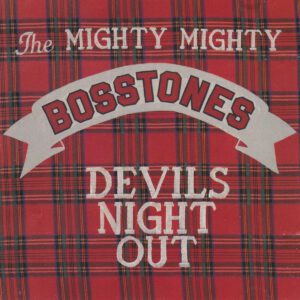
Label: Taang!
Producer: Paul Q. Kolderie / Sean Slade
Release Year: 1990
Listen: Spotify / Apple Music
The Mighty Might Bosstones played our block party when I was in college. That was 1992, a year and something after their debut album, Devil’s Night Out, dropped. The bassist came over, drank from our keg(s) and sat in with the cover band playing on our lawn after their set. A band stupidly named Clavin’s Mother after Cheers mailman, Cliff Claven’s, mother that he always talked about, but never appeared on the show. The cover band was thrilled, of course. We wondered why the famous-ish rock dude with the chain wallet wanted to hang out with a bunch of drunken frat boys. But if you’ve ever heard the Bosstone’s music, that should have been real clear.
This is only one of my very peripheral attachments to this rag-tag bunch of Boston ska dudes. My first real boss in NYC grew up in Cambridge, MA and apparently hung around with lead singer, Dicky Barrett drinking and doing whatever drugs he was doing back then. So much so that at local gigs, he apparently played hype man, getting up on stage waving a white t-shirt and skanking and saying “Yeah!” real loud. Or whatever ska punk hype men do. Drunkenly. He was a good guy, and for some reason had a British accent despite growing up in the US. And most of his stories started of “This one time I did heroin…” Problem is, if you start most of your stories that way, it wasn’t “one time.”
That’s all separate and apart from Devil’s Night Out, of course. But this music kind of feels like that to me. My first reference for this ska punk being my hometown band, Fishbone. A group I saw a few times back in the day and certainly inspired The Bosstones. Them and Madness. Because this group of white dudes will never be Fishbone — nor should they try. So Madness. But they definitely led the way in the white-guys-doing-ska revolution that brought about the short-but-bright rise and fall of groups like Reel Big Fish, Goldfinger and… well, those are the only references I can pull from my brain. Because we’ve all tried to forget the white-guy ska thing. Unless of course you were peripheral ska, but more punk like Operation Ivy and Rancid. They have tattoos and mohawks and are more gutter, so they have the street cred some of these others don’t. And cred was a thing in the 90s. Drake, for instance, wouldn’t have been the biggest thing — a bar mitzvahed child actor from Toronto — in hip-hop in the days of cred.
Ultimately, the Bosstones are a party band. Horns and dancing and drinking and losing their wallets. A bar band who hit on something energy-wise that felt upbeat and fun in a transitional time between the crumbling excess of glam rock and the ascent of the dark tones of grunge and sludge rock. A precursor to the pop punk of Green Day, but with some older feel to it. They’re like an Irish mariachi band. And who doesn’t love that?! And Dickie’s voice… the man is just hoarse. His range is whatever it’s called when you have about three notes you can sing. But with character. A man who sounds perpetually hung over. A man who spent last night yelling at a bar. And tonight yelling at a bar. And tomorrow yelling at a bar. You get it.
The album as a whole is better than I remember it being consistency wise. But it really is music meant to be heard live. Just like block party. It’s drunk music. Blaring horns, skanking, jumping, moshing. You get everything from this record. It’s energetic and light and sunny. Despite inculcating the devil. You know, a Zoot Suit Riot. Another trend — swing — that burned bright, but burned out quick. Cherry Poppin’ Daddies, Big Bad Voodoo Daddy, Fucking Squirrel Nut Zipper Daddy Daddies. It’s all kind of embarrassing. This holds up better, though. Sure, it’s a moment in time that we look upon with some derision. But one that The Bosstones managed to extend and build upon for a few albums after this one with a hit single off each. This album really did star it all, though, by embracing the punk aesthetic and would make for a fun live-ass experience and the fun energy the Richard Marxes of the world weren’t giving us. If only we could only get that damn time machine going back to 1992 when we could all party in a park in Upstate New York and seamlessly enjoy just to enjoy.


